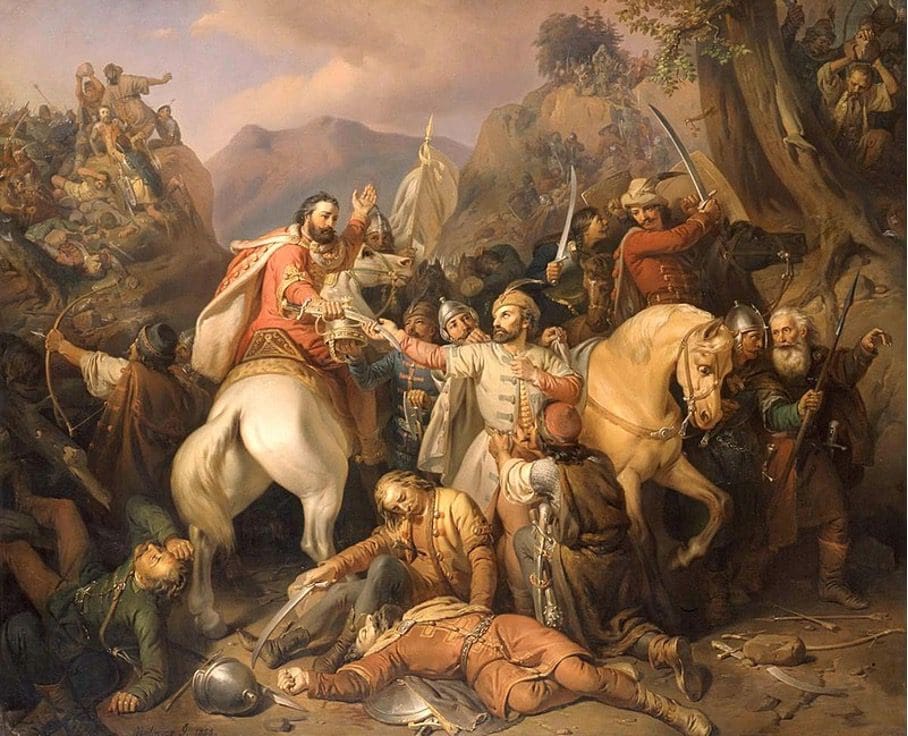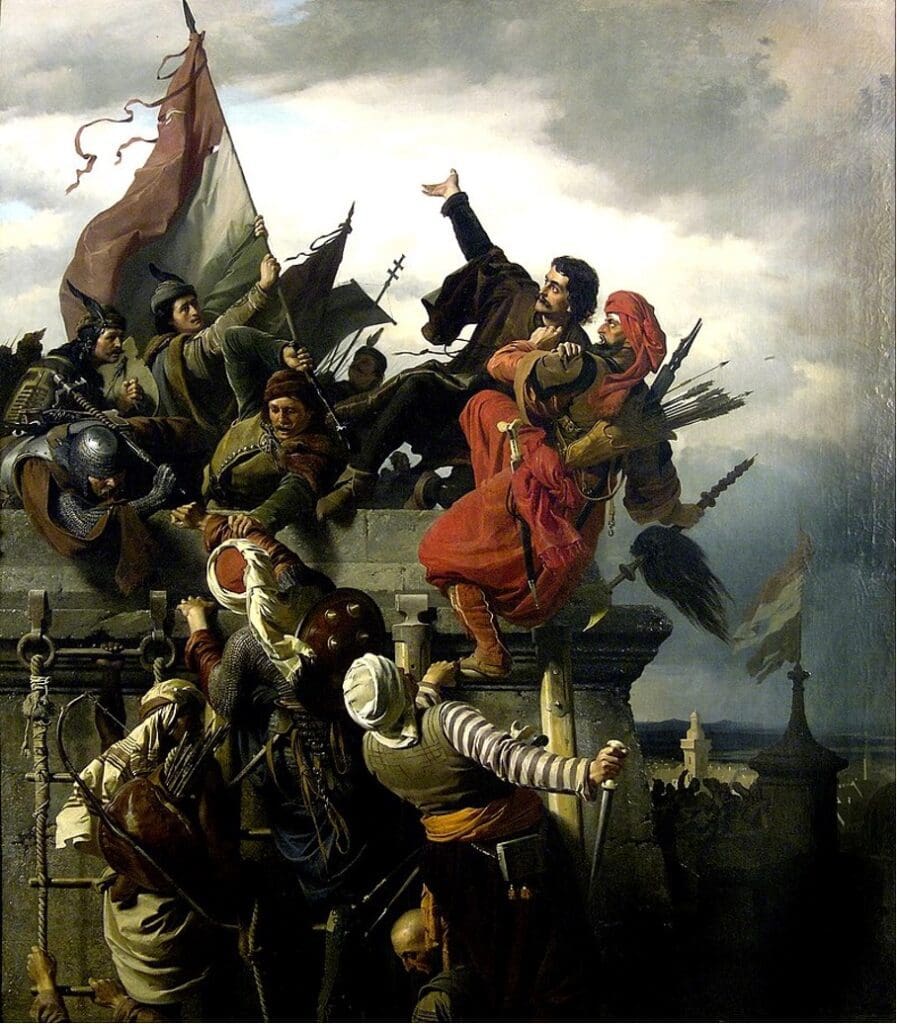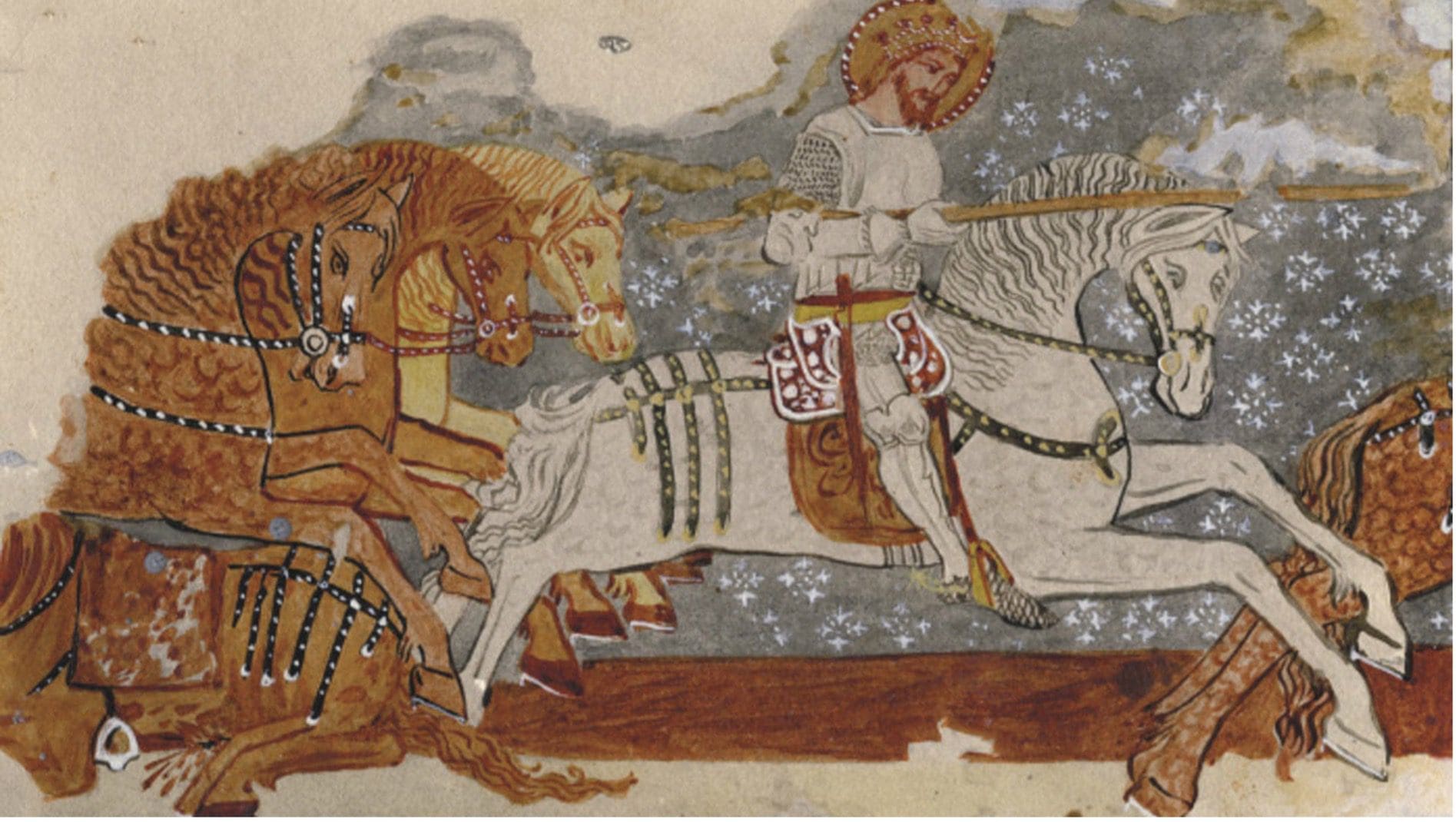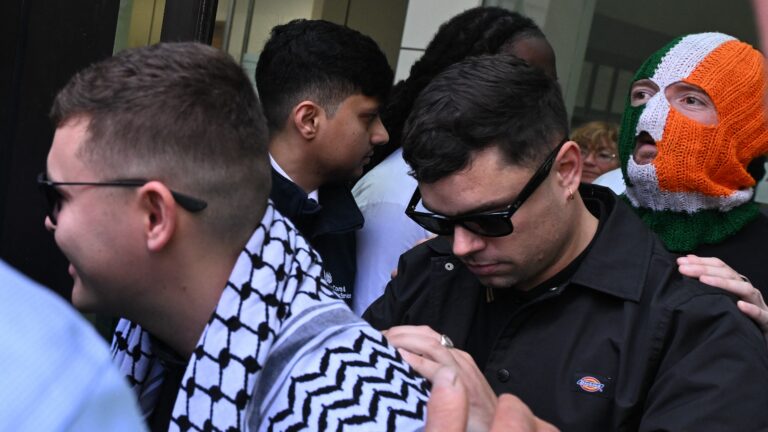In a manual on medieval heroes published in 1993, of the 84 heroes listed five were historical figures at most, while all the others were fictive figures, protagonists of literary works.[1] Is heroism, self-sacrifice and risking one’s life for a noble cause indeed just a dream that flesh-and-blood people would not be capable of? Luckily, no. The ecclesiastical and secular actors of the medieval world, often the protagonists, more than once carried out actions that a narrower or wider social group remained aware of for long periods of time and which it could identify with. They considered the ideals that the names reminded them of as their own, and the heroic actions were looked upon as examples. This idea is well illustrated by a Lorraine author from the 1310s, Jacques de Longuyon, who quickly enumerates medieval heroes in his work. In his writings, Joshua, David, Judas Maccabeus from the Old Testament, Hector, Alexander the Great and Caesar from antiquity, King Arthur, Charlemagne from the Middle Ages and finally Gottfried Bouillon, the hero of the First Crusade, come to life.
The selection is not arbitrary at all: they, the three times three of them became the traditional ‘nine worthies’ (‘Les Neuf Preux’), who were versified, carved out of stone, or painted countless times. Before we laugh at the list, we should not forget that in the Middle Ages, they were all considered real figures, and the German emperor Maximilian I had statues of all of them displayed in the Court Church (Hofkirche) in Innsbruck at the beginning of the 16th century.
While the Hungarian medieval tradition was aware of all these heroes, it preferred to choose its own heroes from domestic history and tradition.
Of course, the oral tradition that immortalized their deeds could be interrupted several times until, thanks to printed works, their exploits became widely known and survived until the modern age.
Medieval society was also known to be a warring society, and Hungary was no different. The act of heroism was often a brave act of valour, which in some way involved risking or losing one’s life. We would expect that heroes came from the upper echelons of society, but this is only partly true. Simple warriors and little-known court knights often appear.
The story of the Hungarian king Saint Ladislaus (reigned 1077 –1095) is a peculiar mix of the secular and sacred spheres, and undoubtedly the source of the most influential narrative and pictorial cycle of the Hungarian Middle Ages. The most exciting part of the Illuminated Chronicle (Chronicon Pictum), copied in the 14th century, is about Saint Ladislaus’s fight against the Pechenegs who invaded the country. In the heat of the battle, Ladislaus is on the trail of a girl-stealing pagan horseman and frees the kidnapped Hungarian girl.
It is not by chance that this scene would become the most common theme of church murals,
of which more than fifty are known today. It might be surprising that even centuries later, as a nun, Princess Saint Margaret of Hungary (d. 1270) enjoyed listening to the stories of Saint Ladislaus defending the country against the pagans with his sword.
The narrative parts of medieval Hungarian royal diplomas provide a striking illustration of who is a hero and what is a heroic deed. Stories narrating the events of battlefields abound from the 1160s to the second half of the 15th century. For those who were granted a diploma, this was the only tool left to perpetuate their own history, their glorious deeds, by which they were able to advance their own and at the same time their family’s political careers. Their personal contribution to the writing was essential, since only the suffering party could know how many teeth they lost in a battle, or which arm was pierced by a crossbow arrow. Thus, King Béla IV justifies his grant to a certain Herbord (1264) as follows: ‘When he fought commendably under our flag, he was taken prisoner by the enemy’s men…in the captivity of the enemies of our country, he was degraded and tortured, one of his ears was cut off and two of his teeth were pulled out…’[2]
Based on the narrations, it appears that the conclusion of the author of the story of William Marshal, or Guillaume le Maréchal (1146/47–1219) in French was justified: ‘I can say with certainty that the courage of a brave man lifts the morale of a whole army.’ The biography written after 1219 was commissioned by William’s son, shortly after the hero’s death, about a knight who, coming from humble beginnings, became, towards the end of his life, the guardian and governor of the English child king.
The unfortunate outcome of the Wallachia campaign of the Hungarian king Charles Robert (reigned 1307–1342) merits special attention. In the so-called Battle of Posada that closed the campaign in November 1330 the enemy set a trap in the mountains and caused huge losses to the royal army. The desperate struggle offered a favourable opportunity for the birth of heroic deeds, which many took. A knight, Dezső Hédervári, saved the life of the king in an act of self-sacrifice by exchanging his armour with his family’s coat of arms with the king’s.[3] At first glance, the story may seem unbelievable, but similar examples also occurred on the Western European battlefields of the time.

During the reign of King Louis the Great (reigned 1342–1382) there were countless opportunities to perform heroic deeds. During the siege of the Belz Castle (today in Ukraine) in 1352, the chronicler praised the heroism of the flag bearer, István Bebek. During the fighting, three flagpoles were broken in his hand, and after the destruction of the fourth, he withdrew from the fight only because he did not have a fifth flag.
It is surprising that a foreign hero managed to enter Hungarian historical memory, obscuring the role of King Sigismund (ruled 1387–1437). In several diplomas, the king praised the Polish Black Zawisza with warm words. At the cost of sacrificing his life, the knight protected the king and the Hungarian camp in 1427, when the besieging Hungarian army was forced to flee from the arriving Ottoman troops at Golubac Castle located on the right bank of the Danube.
The king who had to cross the Danube by boat owed his life to the bravery of the knight who covered the retreat.
And King Sigismund did express his gratitude: he gave Zawisza’s widow 300 Hungarian gold florins. His figure has also entered Polish folklore, and a proverb has preserved his reliability: ‘Trust him like he was Zawisza.’ This was also confirmed by the Hungarian chronicler when he dedicated twenty lines to the siege of Galambóc, but allocated four of them to the Polish hero: ‘Although many people died in this battle, it is still remembered with heartfelt sadness to our time that the famous “Black Zavisa” fell here, a man excellent in prowess and weapon mastery.’[4]
In another case, a person who never set foot in the country was honoured as a hero in Hungary. He is the Albanian Iskander Bey (or Skanderbeg, reigned 1443–1468), who after his confrontation with the Ottomans became an emblematic figure of the Balkan freedom struggles. It is characteristic that the Pope reminded the Hungarian king Matthias (reigned 1458–1490) of the deeds of Iskander Bey upon his accession to the throne. Hungarian humanist historians also mention him approvingly. In 1579, Miklós Bogáti Fazekas wrote a historical poem about him in Hungarian, published in print, describing him ‘as a great example of valiant people’, ensuring his immortality in Hungary as well.
And what about the women? In the winter of 1440, the Holy Crown was kept in a sealed room opening from the treasury in the Visegrád castle. It was stolen from here on the night of 21 February by a Mrs János Kottaner, the chambermaid of the widow of King Albert I, Queen Elizabeth. She gave a detailed account of her adventure in her memoir written in German. At night, by candlelight, she stole the crown after laboriously opening the locks on the door. Then she and the pregnant queen crossed the frozen Danube to Komárom (now Komarno) on a sledge, where the next day the heir to the throne was born. The question is, was the theft of the crown truly an act of heroism, as because of it the country was pushed into a civil war for over a decade? Well, as a regent, János Hunyadi (1446 –1453) certainly appreciated it, as he rewarded the chambermaid with a grant.
What is a feat? The perception of this may vary according to the historical age in which it was achieved. It was possible to carry out a life-threatening act for both good and bad purposes, since the Latin word itself—facinus —means both a good and an evil deed. But even the participants themselves could not always see exactly which side they were on: many times it was too posterity to decide.
The story of Titusz Dugovics exemplifies the case of a heroic deed that cries out for a hero.
In his work, the humanist chronicler Antonio Bonfini did not name the Hungarian hero who, during the siege of Belgrade in 1456, ‘pursues a Turk, and before [the Turk] throws down the national flag, they start wrestling on the top of the tower…and then from the highest peak he [the Hungarian man] jumps into the depths pulling the Turk down with himself.’[5] In the 19th century, the nameless hero was identified as a certain Titus Dugovics, but we now know that the name was fictitious, even if the exploit may have been real.

There is nothing to be surprised about: the connection between heroes and the flag has always been close. Around 1500, Leonardo da Vinci also painted the struggle for the flag in Florence as the central image of the Battle of Anghiari. The successful defence of Scutari, today’s Shkodër in Albania, against the Ottomans in 1474 proves the psychological significance of destroying the opponent’s flag. After the 96-day siege, the Ottomans launched a decisive attack, when in a desperate fight two monks prevented the Ottomans from displaying their battle insignia. Unlike the Hungarian warrior, they survived the heroic deed, and with their names recorded, they received a Venetian ‘state’ annuity, which was paid to them for years to come.[6]
As in all ages, heroic deeds, life-risking courage, and self-sacrifice were part of everyday life, but not everyone was capable of them. Society respected and remembered the heroes’ actions, but whether their memory survived depended on several factors, not the least of which was whether they were included in the blood circulation of book printing, or in the contemporary canons of painting or literature.
[1] Willem P. Gerritsen and Anthony G. van Melle (eds.), A Dictionary of Medieval Heroes: Characters in Medieval Narrative Traditions and their Afterlife in Literature, Theatre and the Visual Arts, Rochester, N.Y., Boydell, 1993.
[2] Gyula Kristó (ed.), Középkori históriák oklevelekben, 1002-1410, Szeged, 1992, 56.
[3] Gréta Somogyi, László Veszprémy, ‘Károly Róbert magyar király 1330-as havasalföldi hadjárata és az ún. posadai csata historiográfiája,’ Hadtörténelmi Közlemények vol. 127 (2014), 23-40.
[4] László Veszprémy, ‘King Sigismund of Luxemburg at Golubac (Galambóc)’, Transylvanian Review, vol. 18, No. 2 (2009), 291-308.
[5] Tibor Szőcs, ‘Egy ‘legendás’ hős: Dugovics Titusz története,’ Hadtörténelmi Közlemények, vol. 12 (2009), 3–35.
[6] Oliver Jens Schmitt, Das venezianische Albanien 1392-1479, München, 2001, 615.








